Quantification of Energy-Related Parameters for Near-Fault Pulse-Like Seismic Ground Motions
Abstract
1. Introduction
2. Nonlinear Modeling of the Inelastic Behavior
3. Energy-Related Parameters
- -
- inelastic absolute EIaμ and relative EIrμ input energy for the given ductility demand μ;
- -
- input energy reduction factors, REa = EIa/EIaμ and REr = EIr/EIrμ (i.e., the ratio between the elastic input energy and the inelastic value corresponding to a given ductility demand μ);
- -
- the hysteretic energy dissipation demand EH;
- -
- the hysteretic energy reduction factors, RHa = (EH/EIa)μ and RHr = (EH/EIr)μ (i.e., the ratio between the hysteretic energy dissipation demand and the inelastic input energy value corresponding to a given ductility demand μ);
- -
- the parameter η that quantifies the plasticity level in terms of dimensionless cumulative plastic deformation ratio, i.e., η = EH/(Ryδy), where Ry and δy are the elastic limit strength and displacement, respectively.
4. Database of Horizontal Fault-Normal Pulse-like Seismic Ground Motion Records
5. Sensitivity Analysis
5.1. Clustering of Seismic Records
5.2. Influence of Seismological Parameters
5.3. Influence of Hysteretic Model and Ductility Level
6. Closed-Form Approximation of Energy-Related Spectra
7. Conclusions
Supplementary Materials
Author Contributions
Funding
Conflicts of Interest
Appendix A
| μ | a2 | n2 | |||||
|---|---|---|---|---|---|---|---|
| A | B | C | D | E | F | ||
| NDHYST | 1.5 | −0.0214 | 0.6475 | 3.3569 | −19.1032 | −0.2048 | 2.6237 |
| 2 | −0.0241 | 0.7816 | 1.7847 | −9.9522 | −0.1780 | 2.451 | |
| 3 | −0.0269 | 0.8712 | 0.7283 | −3.7004 | −0.1503 | 2.2863 | |
| 4 | −0.0265 | 0.8904 | 0.5117 | −2.4956 | −0.1393 | 2.2247 | |
| 6 | −0.0236 | 0.8791 | 0.3522 | −1.6454 | −0.1410 | 2.2614 | |
| DHYST | 1.5 | −0.0280 | 0.6092 | 1.5008 | −7.9736 | −0.1858 | 2.5178 |
| 2 | −0.0303 | 0.7304 | 1.1577 | −6.1035 | −0.1816 | 2.4935 | |
| 3 | −0.0310 | 0.7926 | 1.3923 | −7.7803 | −0.1985 | 2.6131 | |
| 4 | −0.0308 | 0.8027 | 1.1361 | −6.3390 | −0.2009 | 2.6494 | |
| 6 | −0.0309 | 0.7957 | 0.4391 | −2.1689 | −0.1872 | 2.5922 | |
| μ | a2 | n2 | |||||
|---|---|---|---|---|---|---|---|
| A | B | C | D | E | F | ||
| NDHYST | 1.5 | −0.0194 | 0.6978 | 1.8259 | −9.9142 | −0.1292 | 2.0273 |
| 2 | −0.0175 | 0.7984 | 1.6756 | −9.1343 | −0.1207 | 1.9585 | |
| 3 | −0.0216 | 0.8996 | 0.4226 | −2.0704 | −0.0716 | 1.6473 | |
| 4 | −0.0238 | 0.9356 | 0.3371 | −1.6183 | −0.0814 | 1.723 | |
| 6 | −0.0179 | 0.9084 | 0.1269 | −0.4014 | −0.0891 | 1.7948 | |
| DHYST | 1.5 | −0.0200 | 0.6151 | 1.7104 | −9.4731 | −0.1325 | 2.0556 |
| 2 | −0.0213 | 0.7275 | 1.2304 | −6.6671 | −0.1231 | 1.9848 | |
| 3 | −0.0305 | 0.8451 | 1.0438 | −5.7996 | −0.1085 | 1.8823 | |
| 4 | −0.0313 | 0.8656 | 0.8527 | −4.7955 | −0.1178 | 1.9639 | |
| 6 | −0.0351 | 0.8852 | 1.2214 | −7.1531 | −0.1431 | 2.1494 | |
| μ | a2 | n2 | |||||
|---|---|---|---|---|---|---|---|
| A | B | C | D | E | F | ||
| NDHYST | 1.5 | −0.0284 | 0.6322 | 1.8462 | −9.9993 | −0.2316 | 3.0642 |
| 2 | −0.0302 | 0.7707 | 1.3410 | −7.1059 | −0.2167 | 2.9499 | |
| 3 | −0.0311 | 0.8532 | 0.8433 | −4.3001 | −0.1731 | 2.6424 | |
| 4 | −0.0279 | 0.8527 | 0.6123 | −3.0186 | −0.1420 | 2.4353 | |
| 6 | −0.0236 | 0.8290 | 0.4360 | −2.0789 | −0.1412 | 2.4537 | |
| DHYST | 1.5 | −0.0308 | 0.5767 | 1.4665 | −7.6810 | −0.2164 | 2.9881 |
| 2 | −0.0335 | 0.7065 | 1.5794 | −8.6345 | −0.2171 | 2.9481 | |
| 3 | −0.0357 | 0.7786 | 0.9515 | −4.9649 | −0.2303 | 3.0589 | |
| 4 | −0.0342 | 0.7772 | 0.7070 | −3.6003 | −0.2108 | 2.9318 | |
| 6 | −0.0298 | 0.7392 | 0.4812 | −2.3486 | −0.2026 | 2.9057 | |
References
- Archuleta, R.J.; Hartzell, S.H. Effects of fault finiteness on near-source ground motion. Bull. Seism. Soc. Am. 1981, 71, 939–957. [Google Scholar]
- Somerville, P.G.; Graves, R.W. Conditions that give rise to unusually large long period ground motions. In Proceedings of the Seminar on Seismic Isolation, Passive Energy Dissipation and Active Control, Applied Technology Council, San Francisco, CA, USA, 11–12 March 1993; pp. 83–94. [Google Scholar]
- Hall, J.F.; Heaton, T.H.; Halling, M.W.; Wald, D.J. Near-source ground motion and its effects on flexible buildings. Earthq. Spectra 1995, 11, 569–605. [Google Scholar] [CrossRef]
- Somerville, P.G.; Smith, N.F.; Graves, R.W.; Abrahamson, N.A. Modification of empirical strong ground motion attenuation relations to include the amplitude and duration effects of rupture directivity. Seism. Res. Lett. 1997, 68, 199–222. [Google Scholar] [CrossRef]
- Menun, C.; Fu, Q. An analytical model for near-fault ground motions and the response of SDOF systems. In Proceedings of the 7th U.S. National Conference on Earthquake Engineering, Boston, MA, USA, 21–25 July 2002. [Google Scholar]
- Mavroeidis, G.P.; Papageorgiou, A.S. A mathematical representation of near-fault ground motions. Bull. Seism. Soc. Am. 2003, 93, 1099–1131. [Google Scholar] [CrossRef]
- Bray, J.D.; Rodriguez-Marek, A. Characterization of forward-directivity ground motions in the near-fault region. Soil Dyn. Earthq. Eng. 2004, 24, 815–828. [Google Scholar] [CrossRef]
- Mollaioli, F.; Bruno, S.; Decanini, L.D.; Panza, G.F. Characterization of the dynamic response of structures to damaging pulse-type near-fault ground motions. Meccanica 2006, 41, 23–46. [Google Scholar] [CrossRef]
- Baker, J.W. Quantitative classification of near-fault ground motions using wavelet analysis. Bull. Seism. Soc. Am. 2007, 97, 1486–1501. [Google Scholar] [CrossRef]
- Lu, Y.; Panagiotou, M. Characterization and representation of near-fault ground motions using cumulative pulse extraction with wavelet analysis. Bull. Seism. Soc. Am. 2013, 104, 410–426. [Google Scholar] [CrossRef]
- Mukhopadhyay, S.; Gupta, V.K. Directivity pulses in near-fault ground motions—I: Identification, extraction and modeling. Soil Dyn. Earthq. Eng. 2013, 50, 1–15. [Google Scholar] [CrossRef]
- Chang, Z.; Sun, X.; Zhai, C.; Zhao, J.X.; Xie, L. An improved energy-based approach for selecting pulse-like ground motions. Earthq. Eng. Struct. Dyn. 2016, 45, 2405–2411. [Google Scholar] [CrossRef]
- Dabaghi, M.; Der Kiureghian, A. Simulation of orthogonal horizontal components of near-fault ground motion for specified earthquake source and site characteristics. Earthq. Eng. Struct. Dyn. 2018, 47, 1369–1393. [Google Scholar] [CrossRef]
- Quaranta, G.; Mollaioli, F. Analysis of near-fault pulse-like seismic signals through Variational Mode Decomposition technique. Eng. Struct. 2019, 193, 121–135. [Google Scholar] [CrossRef]
- Makris, N. Rigidity-plasticity-viscosity: Can electrorheological dampers protect base-isolated structures from near-source ground motions? Earthq. Eng. Struct. Dyn. 1997, 26, 571–591. [Google Scholar] [CrossRef]
- Alavi, B.; Krawinkler, H. Behavior of moment-resisting frame structures subjected to near-fault ground motions. Earthq. Eng. Struct. Dyn. 2004, 33, 687–706. [Google Scholar] [CrossRef]
- Rupakhety, R.; Sigbjörnsson, R. Can simple pulses adequately represent near-fault ground motions? J. Earthq. Eng. 2011, 15, 1260–1272. [Google Scholar] [CrossRef]
- Alonso-Rodríguez, A.; Miranda, E. Assessment of building behavior under near-fault pulse-like ground motions through simplified models. Soil Dyn. Earthq. Eng. 2015, 79, 47–58. [Google Scholar] [CrossRef]
- Mazza, M. Effects of near-fault ground motions on the nonlinear behaviour of reinforced concrete framed buildings. Earthq. Sci. 2015, 28, 285–302. [Google Scholar] [CrossRef][Green Version]
- Quaranta, G.; Mollaioli, F.; Monti, G. Effectiveness of design procedures for linear TMD installed on inelastic structures under pulse-like ground motion. Earthq. Struct. 2016, 10, 239–260. [Google Scholar] [CrossRef]
- MacRae, G.A.; Morrow, D.W.; Roeder, C.W. Near-fault ground motion effects on simple structures. J. Struct. Eng. 2001, 127, 996–1004. [Google Scholar] [CrossRef]
- Cuesta, I.; Aschheim, M.A. Inelastic response spectra using conventional and pulse R-factors. J. Struct. Eng. 2001, 127, 1013–1020. [Google Scholar] [CrossRef]
- Mavroeidis, G.P.; Dong, G.; Papageorgiou, A.S. Near-fault ground motions, and the response of elastic and inelastic single-degree-of-freedom (SDOF) systems. Earthq. Eng. Struct. Dyn. 2004, 33, 1023–1049. [Google Scholar] [CrossRef]
- Kalkan, E.; Kunnath, S.K. Effects of fling-step and forward directivity on the seismic response of buildings. Earthq. Spectra 2006, 22, 367–390. [Google Scholar] [CrossRef]
- Tong, M.; Rzhevsky, V.; Junwu, D.; Lee, G.C.; Jincheng, Q.; Xiaozhai, Q. Near-fault ground motion with prominent acceleration pulses: Pulse characteristics and ductility demand. Earthq. Eng. Eng. Vib. 2007, 6, 215–223. [Google Scholar] [CrossRef]
- Hatzigeorgiou, G.D.; Pnevmatikos, N.G. Maximum damping forces for structures with viscous dampers under near-source earthquakes. Eng. Struct. 2014, 68, 1–13. [Google Scholar] [CrossRef]
- Makris, N.; Black, C. Evaluation of peak ground velocity as a good intensity measure for near-source ground motions. J. Eng. Mech. 2004, 130, 1032–1044. [Google Scholar] [CrossRef]
- Mollaioli, F.; Bruno, S. Influence of site effects on inelastic displacement ratios for SDOF and MDOF systems. Comput. Math. Appl. 2008, 55, 184–207. [Google Scholar] [CrossRef]
- Donaire-Ávila, J.; Benavent-Climent, A.; Lucchini, A.; Mollaioli, F. Energy-based seismic design methodology: A preliminary approach. In Proceedings of the 16th World Conference on Earthquake Engineering, 16WCEE 2017, Paper N° 2106. Santiago, Chile, 9–13 January 2017. [Google Scholar]
- Kalkan, E.; Kunnath, S.K. Relevance of absolute and relative energy content in seismic evaluation of structures. Adv. Struct. Eng. 2008, 11, 17–34. [Google Scholar] [CrossRef]


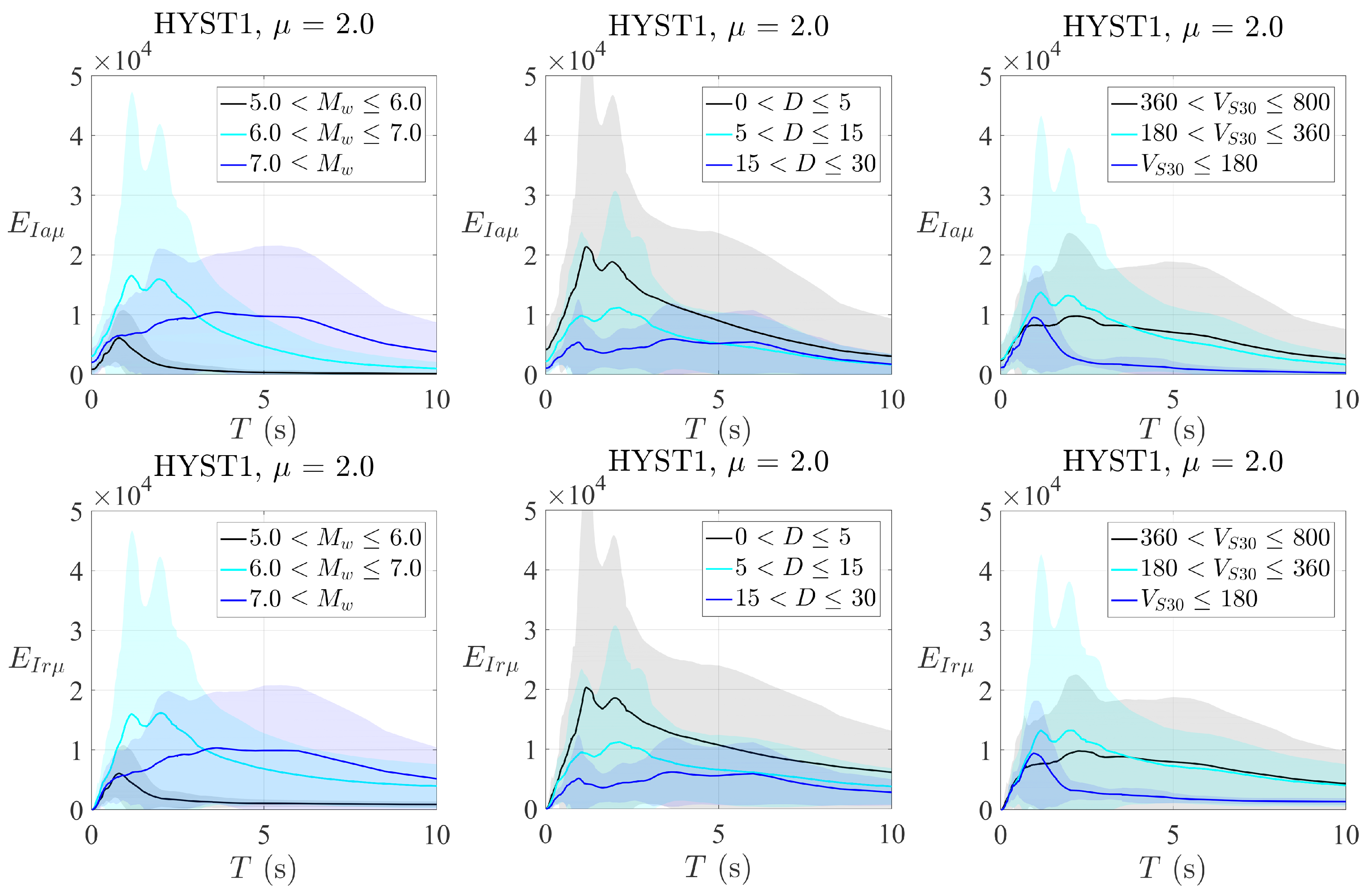

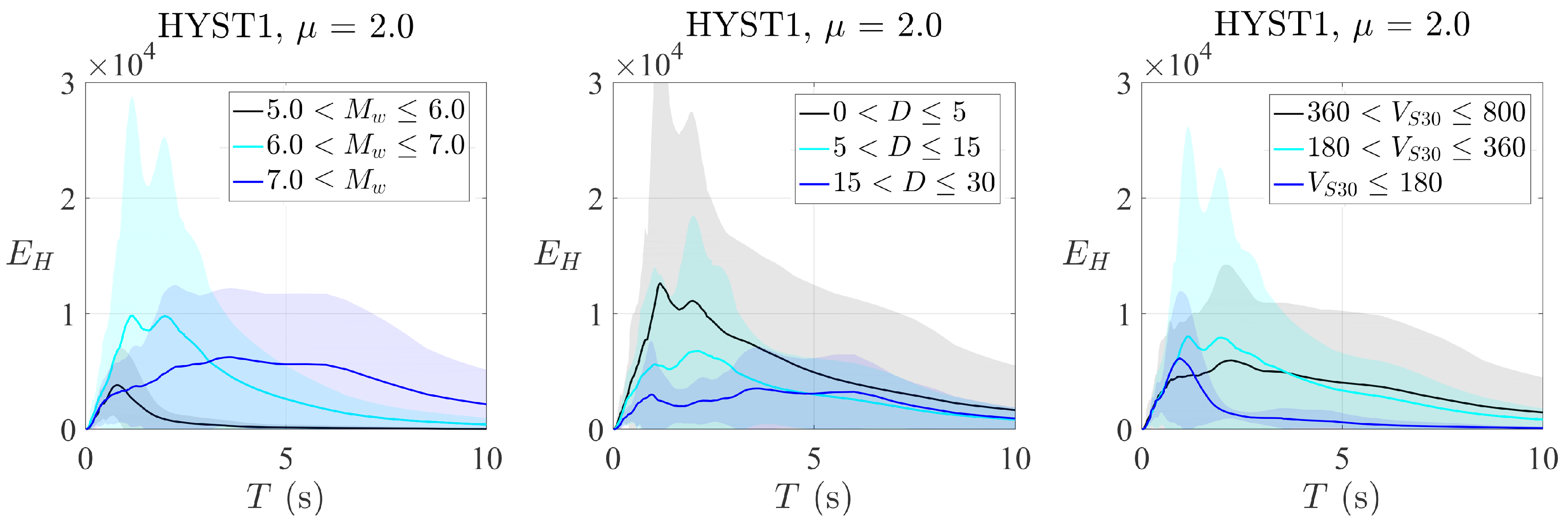



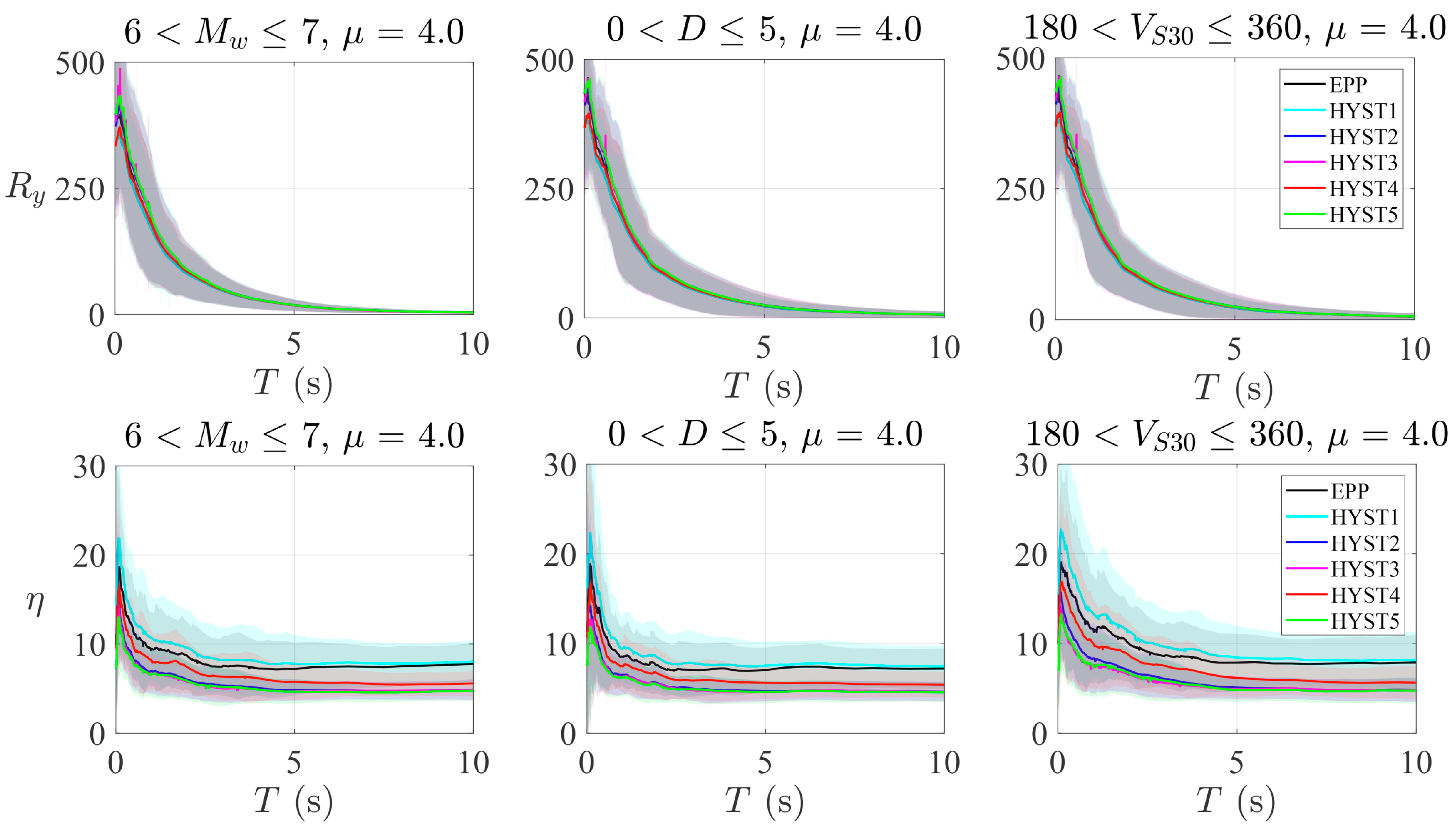
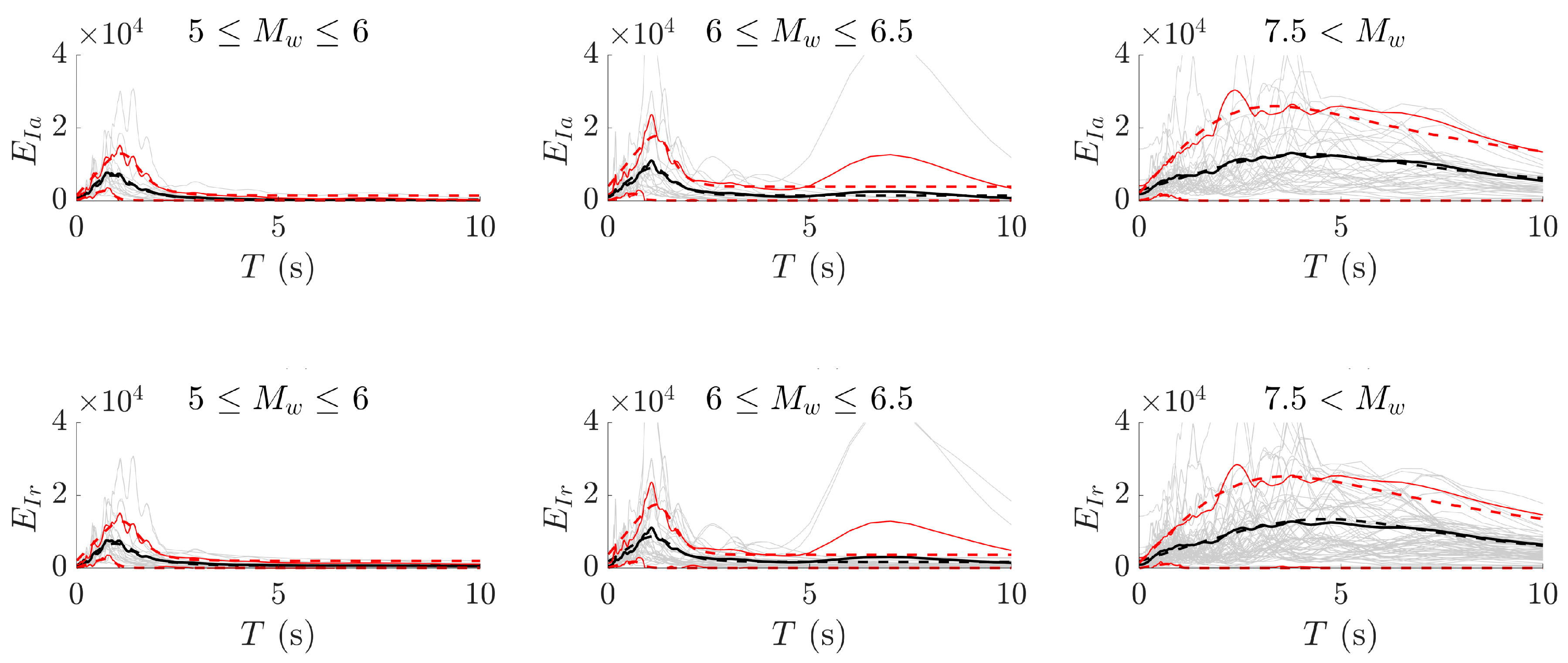
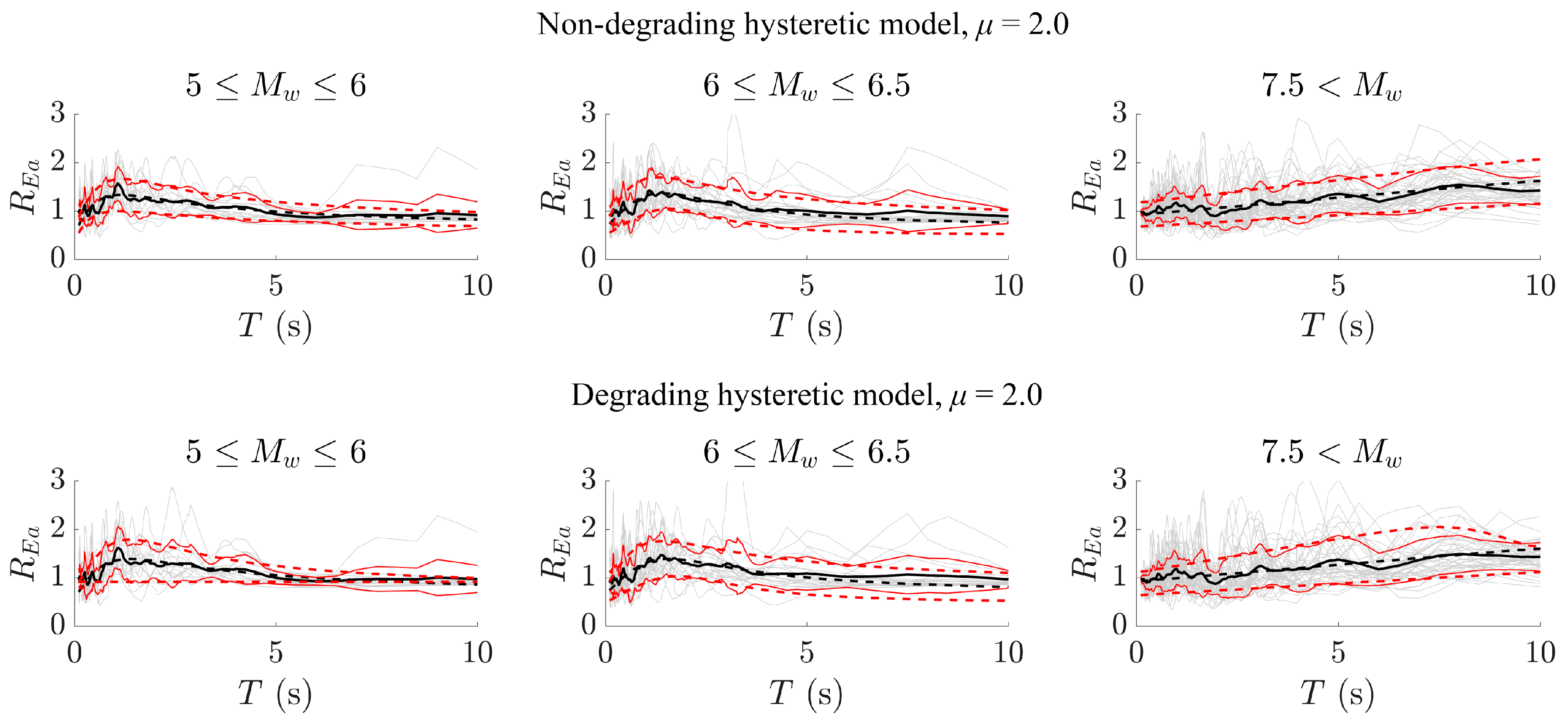
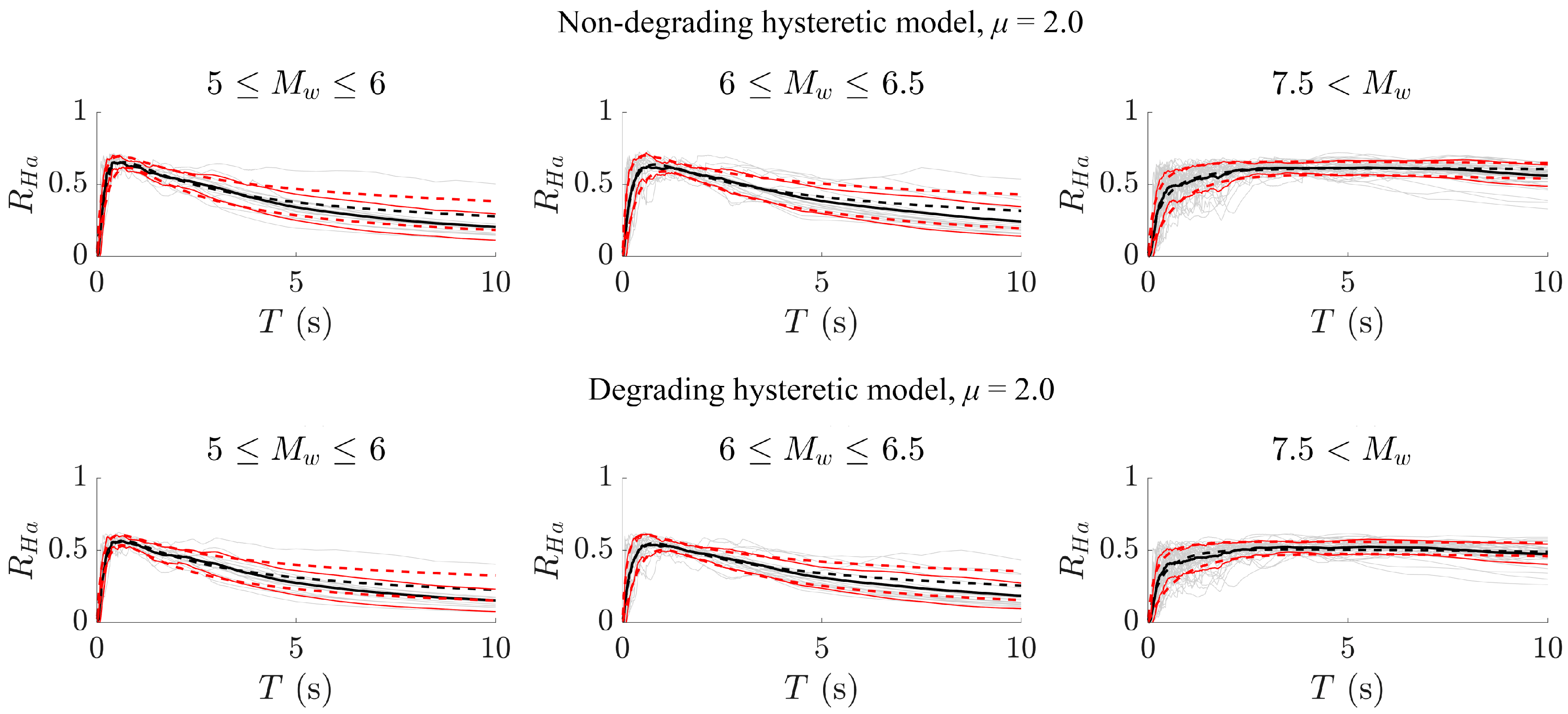

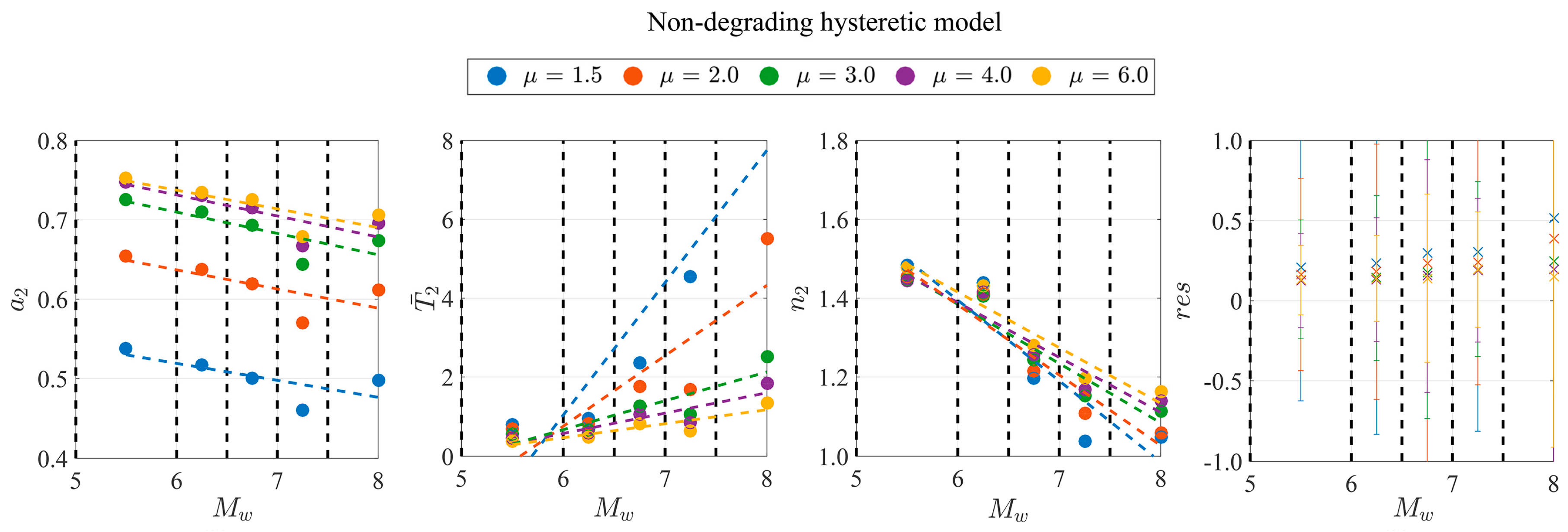
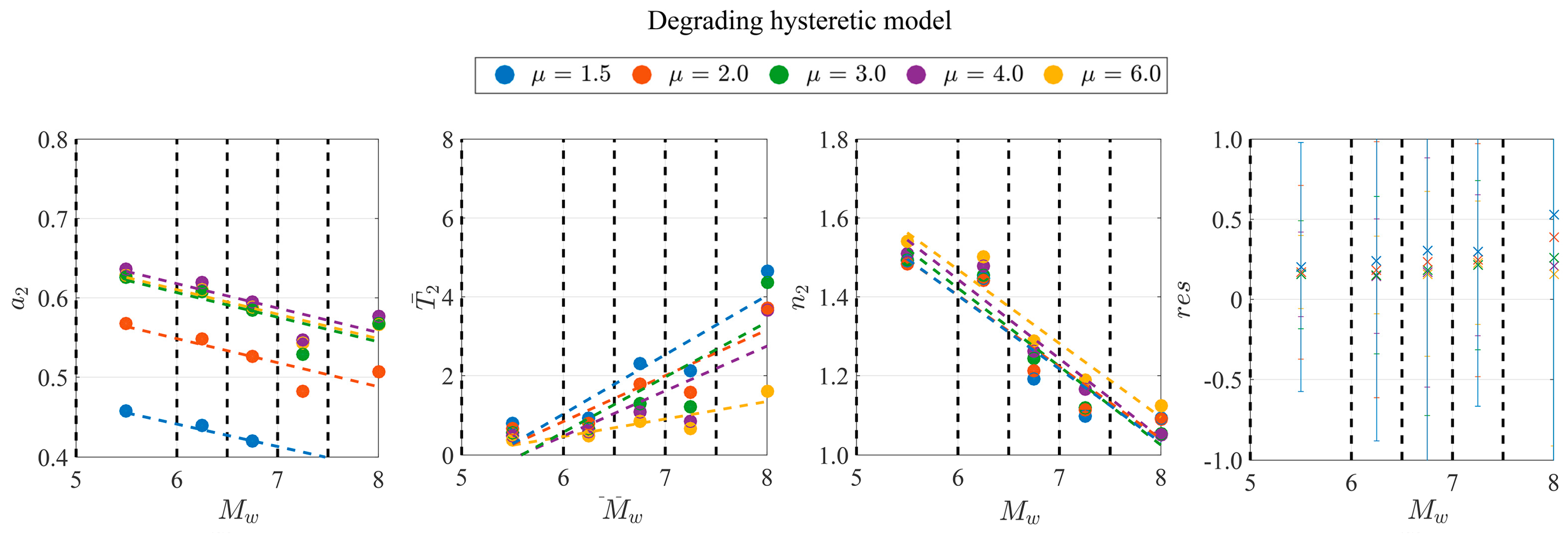
| Model Tag | Model Description |
|---|---|
| EPP | Elastic-perfectly plastic model including Bauschinger effect |
| HYST1 | Elastoplastic model with hardening |
| HYST2 | Bilinear model with stiffness and low strength degradation, and pinching effect |
| HYST3 | Bilinear model with stiffness and high strength degradation, and pinching effect |
| HYST4 | Takeda’s model |
| HYST5 | Bilinear model with strain softening and stiffness degradation |
| Model Tag | p | α | β | γ | ρ |
|---|---|---|---|---|---|
| EPP | 0 | 100 | 0 | 1 | - |
| HYST1 | 0.1 | 100 | 0 | 1 | 0.8 |
| HYST2 | 0.05 | 2 | 0.1 | 0.5 | 0.8 |
| HYST3 | 0.05 | 2 | 0.1 | 0.5 | 0.5 |
| HYST4 | 0.1 | 2 | 0 | 1 | 0.8 |
| HYST5 | −0.01 | 1 | 0.05 | 1 | 0.5 |
| Moment Magnitude Mw | Closest Site-to-Source Distance Df (km) | Soil Type VS30 (m/s) |
|---|---|---|
| 5–6 (14) | 0–5 (31) | <180 (10) |
| 6–7 (64) | 5–15 (63) | 180–360 (66) |
| >7 (49) | 15–30 (24) | 360–800 (51) |
Publisher’s Note: MDPI stays neutral with regard to jurisdictional claims in published maps and institutional affiliations. |
© 2020 by the authors. Licensee MDPI, Basel, Switzerland. This article is an open access article distributed under the terms and conditions of the Creative Commons Attribution (CC BY) license (http://creativecommons.org/licenses/by/4.0/).
Share and Cite
AlShawa, O.; Angelucci, G.; Mollaioli, F.; Quaranta, G. Quantification of Energy-Related Parameters for Near-Fault Pulse-Like Seismic Ground Motions. Appl. Sci. 2020, 10, 7578. https://doi.org/10.3390/app10217578
AlShawa O, Angelucci G, Mollaioli F, Quaranta G. Quantification of Energy-Related Parameters for Near-Fault Pulse-Like Seismic Ground Motions. Applied Sciences. 2020; 10(21):7578. https://doi.org/10.3390/app10217578
Chicago/Turabian StyleAlShawa, Omar, Giulia Angelucci, Fabrizio Mollaioli, and Giuseppe Quaranta. 2020. "Quantification of Energy-Related Parameters for Near-Fault Pulse-Like Seismic Ground Motions" Applied Sciences 10, no. 21: 7578. https://doi.org/10.3390/app10217578
APA StyleAlShawa, O., Angelucci, G., Mollaioli, F., & Quaranta, G. (2020). Quantification of Energy-Related Parameters for Near-Fault Pulse-Like Seismic Ground Motions. Applied Sciences, 10(21), 7578. https://doi.org/10.3390/app10217578







